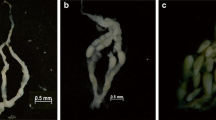Summary
Colonies of Anelosimus eximius in Panama had an average sex ratio of 0.15±sd 0.09, i.e. about five females for each male. The sex ratio in egg sacs reared was even lower (0.08±0.01), as was that of immatures in newly founded colonies (0.12±0.05). The possible mechanisms responsible are discussed. Mature colonies had an average ratio of 17 females and 2 males for each egg sac present (range: 2–91 females, 0.2–8.2 males) and contained a large proportion of females which were not inseminated but which presumably ‘help’. Since both sexes are diploid, arrhenotoky can be ruled out and it is assumed that some females do not come to reproduction, the proportion depending on the availability of resources. This mechanism may enable entire colonies to survive lean times.
Similar content being viewed by others
References
Aviles L (in press) Sex ratio bias in the social spider Anelosimus eximius, with comments on the possibility of group selection. Am Nat
Brach V (1975) The biology of the social spider Anelosimus eximius. Bull South Calif Acad Sci 74:37–41
Bull JJ (1983) Evolution of sex determining mechanisms. Benjamin Cummings. Menlo Park, Ca
Burgess JW (1976) Social spiders. Sci Am 234:101–106
Buskirk RE (1981) Sociality in the Arachnida. In: Social Insects, vol II, Hermann HR (ed). Academic Press, New York, pp 282–393
Charnov EL (1982) The theory of sex allocation. Princeton University Press, Princeton, NJ
Christenson TE (1984) Behaviour of colonial and solitary spiders of the theridiid species Anelosimus eximius. Anim Behav 32:725–734
Hamilton WD (1964) The genetical evolution of social behaviour, I+II. J Theor Biol 7:1–16, 17–52
Hamilton WD (1967) Extraordinary sex ratios. Science 156:477–488
Harris H, Hopkinson DA (1978) Handbook of enzyme electrophoresis in human genetics. Elsevier, Holland
Krafft B (1970) Les rythmes d'activité d'Agelena consociata Denis: Activite de tissage et activité locomotrice. Biol Gabonica 6:99–130
Kreutzer RD, Galindo P (1980) Isozyme studies of two Melanocoion mosquitoes, Culex ocossa and Cx. panocossa. Mosq News 40:605–613
Kullmann E (1972) Evolution of social behaviour in spiders. Am Zool 12:419–426
Lacy RC (1980) The origin of eusociality in termites: a haploid analogy? Am Nat 116:449–451
Levi HW (1956) The spider genera Neottiura and Anelosimus in America. Trans Am Microsc Soc 82:407–422
Lewis KR, John B (1957) Bivalent structure in Periplaneta americana. Nature 179:973–974
Lubin YD, Robinson MH (1982) Dispersal by swarming in a social spider. Science 216:319–321
Nentwig W (1985) Social spiders catch larger prey: a study of Anelosimus eximius (Araneae: Theridiidae). Behav Ecol Sociobiol 17:79–85
Novitzki E, Peacock WJ, Engel J (1965) Cytological basis of sex ratio in Drosophila pseudoobscura. Science 148:345–357
Overal WL, Ferreira da Silva PaR (1982) Population dynamics of the quasisocial spider Anelosimus eximius (Araneae: Theridiidae). In: Breed MD, Michener CD, Howard HE (eds) The biology of social insects. Westview Press, Boulder Col, pp 181–181
Robinson MH, Robinson B (1970) The prey caught by a sample population of the spider Argiope argentata in Panama: A years' census data. Zool J Linn Soc 49:345–357
Sekiguchi K (1955) Differences in the spinning organs between male and female adult spiders. Sci Rep Tokyo Kyoiku Daigaku Sect B 8:23–32
Shear WA (1970) The evolution of social phenomena in spiders. Bull Br Arachnol Soc 1:65–77
Simon E (1891) Observations biologiques sur les Arachnides. Ann Soc Entomol France 60:5–16
Smith DRR (1985) Population dynamics of Anelosmius eximius (Theridiidae). J Arachnol (in press)
Strassman JE (1984) Female biased sex ratios in social insects lacking morphological castes. Evolution 38:256–266
Syren RM, Luyckx P (1977) Permanent segmental interchange complex in the termite Incisitermes schwarzi. Nature 266:167–168
Tapia Y, De Vries T (1981) Tolerancia y cooperation en la Araña social Anelosimus jucundus des bosque tropical Rio Palenque, Ecuador. Rev Univ Catholica Ecuador 8:51–74
Trivers RL, Hare H (1976) Haplodiploidy and the evolution of the social insects. Science 191:249–263
Vollrath F (1980) Male body size and fitness in the web-building spider Nephila clavipes. Z Tierpsychol 53:61–78
Vollrath F (1982) Colony foundation in a social spider. Z Tierpsychol 60:313–324
Vollrath F, Rohde-Arndt D (1983) Prey capture and feeding in the social spider Anelosimus eximius. Z Tierpsychol 61:334–340
Vollrath F, Windsor D (in press) Subsocial and social Anelosimus: a comparison especially of nest defence. In: Robinson MH (ed) Proceedings IXth Internatl Arachnol Congress
West MJ (1967) Foundress associations in polistine wasps: dominance hierarchies and the evolution of social behaviour. Science 157:1584–1585
White MJD (1973) Animal cytology and evolution. (3rd ed) Cambridge University Press, Cambridge, UK
Wilson EO (1971) The social insects. Belknap Press of Harvard University Press, Cambridge, MA
Wilson DS, Colwell RK (1981) Evolution of sex ratio in structured demes. Evolution 35:882–897
Zimmering S, Sandler L, Nicoletti B (1970) Mechanisms of meiotic drive. Annu Rev Genet 4:409–436
Author information
Authors and Affiliations
Rights and permissions
About this article
Cite this article
Vollrath, F. Eusociality and extraordinary sex ratios in the spider Anelosimus eximius (Araneae: Theridiidae). Behav Ecol Sociobiol 18, 283–287 (1986). https://doi.org/10.1007/BF00300005
Received:
Accepted:
Issue Date:
DOI: https://doi.org/10.1007/BF00300005




